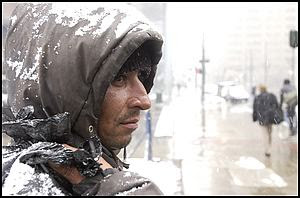I’ve been vaguely aware of a movement within the Christian community called New Monasticism or Neo-monasticism for a while now. But I’m finding it floating to my mind and touching my heart much more frequently of late. Wikipedia has a pretty good short summary of what they’re about.
What attracts me to them is how they’re engaging full spiritual lives, in a sense reclaiming that generally rejected term “religious,” in its richest sense. As a Western Buddhist ordained in the Japanese inheritance, a system rejected by most continental Buddhists as not “real” ordination, which for them is vinaya and only vinaya, thinking of what we are who are ordained in a tradition well over a thousand years old and yet marginalized, has relevance for me. Now I’m aware of the many problems within my inheritance in our use of monastic language for a type of practice that is almost never celibate, and the kaleidoscopic variety of how we’re manifesting, witnessing this emergent Christian movement and where they’re placing their focus has opened a flood gate of hope for me and for our way.
According to that Wikipedia article these wildly diverse neo-monastics managed to get themselves together enough to meet in 2004 in Durham, North Carolina. There they came up with a fascinating list of what they saw as the signal features of what they were doing. They called them “The Twelve Marks.”
The list as presented in the article:
- Relocation to the “abandoned places of Empire” [at the margins of society]
- Sharing economic resources with fellow community members and the needy among us
- Hospitality to the stranger
- Lament for racial divisions within the church and our communities combined with the active pursuit of a just reconciliation
- Humble submission to Christ’s body, the Church
- Intentional formation in the way of Christ and the rule of the community along the lines of the old novitiate
- Nurturing common life among members of an intentional community
- Support for celibate singles alongside monogamous married couples and their children
- Geographical proximity to community members who share a common rule of life
- Care for the plot of God’s earth given to us along with support of our local economies
- Peacemaking in the midst of violence and conflict resolution within communities along the lines of Matthew 18
- Commitment to a disciplined contemplative life
I see many interesting points for us as Western Buddhists in this list, and specifically for us in the Western Zen schools, holding forth possibilities implicit within our tradition, but to my mind and heart, not yet realized.
Each aspect offering a challenge or a context.
Should we be seeking a new community of clouds and water people?
What would it look like for us to establish communities at that edge of the empire?
What would it look like if we took mutual care as a cardinal good and a part of our ordination vows?
What about hospitality and care for the stranger?
What about lives seeking to bridge the gap between the contemplative and those who are oppressed, seeking solidarity with those who are marginalized within our culture?
What about the rending of the fabric of community due to racial identity? And in particular the part of those who share an identity with the majority and who have benefited in ways that have cost others? As an American I think of our relationships with people of African descent or from our first nations, but also as a convert Buddhist how we relate to those Buddhists of Asian descent?
What is submission to the way of the Buddha mean for us? How do we find paths of liberation while not putting another head on top of our own?
How do we form our lives in a more egalitarian culture, where we absolutely need to learn to bow, and yet also need new ways of expressing those bows?
What would intentional community look like for us, if it isn’t simply replicating the hierarchical structures of Zen training temples? Where is a full life?
How do we honor both celibate and non-celibate lives as clouds and water people?
How do we develop forms of community that mix living together and living in proximity?
How do we embrace an interdependent understanding of ecology and economics?
How do we become peacemakers?
How do we conform our vows and our lives to wholeness and healing?
Things I find myself thinking about on a wet and dark morning…













